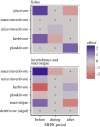Consequences of kelp forest ecosystem shifts and predictors of persistence through multiple stressors
- PMID: 38320605
- PMCID: PMC10846955
- DOI: 10.1098/rspb.2023.2749
Consequences of kelp forest ecosystem shifts and predictors of persistence through multiple stressors
Abstract
Ecological communities can be stable over multiple generations, or rapidly shift into structurally and functionally different configurations. In kelp forest ecosystems, overgrazing by sea urchins can abruptly shift forests into alternative states that are void of macroalgae and primarily dominated by actively grazing sea urchins. Beginning in 2014, a sea urchin outbreak along the central coast of California resulted in a patchy mosaic of remnant forests interspersed with sea urchin barrens. In this study, we used a 14-year subtidal monitoring dataset of invertebrates, algae, and fishes to explore changes in community structure associated with the loss of forests. We found that the spatial mosaic of barrens and forests resulted in a region-wide shift in community structure. However, the magnitude of kelp forest loss and taxonomic-level consequences were spatially heterogeneous. Taxonomic diversity declined across the region, but there were no declines in richness for any group, suggesting compositional redistribution. Baseline ecological and environmental conditions, and sea urchin behaviour, explained the persistence of forests through multiple stressors. These results indicate that spatial heterogeneity in preexisting ecological and environmental conditions can explain patterns of community change.
Keywords: alternative stable states; climate change; community structure; marine heatwave; regime shift; sea urchin.
Conflict of interest statement
We declare we have no competing interests.
Figures





Similar articles
-
Trophic redundancy and predator size class structure drive differences in kelp forest ecosystem dynamics.Ecology. 2020 May;101(5):e02993. doi: 10.1002/ecy.2993. Epub 2020 Feb 28. Ecology. 2020. PMID: 32002994 Free PMC article.
-
Density-dependent feedbacks, hysteresis, and demography of overgrazing sea urchins.Ecology. 2019 Feb;100(2):e02577. doi: 10.1002/ecy.2577. Ecology. 2019. PMID: 30707451
-
The present is the key to the past: linking regime shifts in kelp beds to the distribution of deep-living sea urchins.Ecology. 2017 Jan;98(1):253-264. doi: 10.1002/ecy.1638. Ecology. 2017. PMID: 28052391
-
Testing the efficacy of sea urchin exclusion methods for restoring kelp.Mar Environ Res. 2021 Aug;170:105439. doi: 10.1016/j.marenvres.2021.105439. Epub 2021 Jul 28. Mar Environ Res. 2021. PMID: 34365122 Review.
-
From Individual Calcifiers to Ecosystem Dynamics: Ocean Acidification Effects on Urchins and Abalone.Integr Comp Biol. 2024 Sep 17;64(2):290-305. doi: 10.1093/icb/icae096. Integr Comp Biol. 2024. PMID: 38986515 Review.
Cited by
-
Drivers of spatiotemporal variability in a marine foundation species.Ecol Appl. 2025 Jan;35(1):e3092. doi: 10.1002/eap.3092. Ecol Appl. 2025. PMID: 39957275 Free PMC article.
-
Kelp forest loss and emergence of turf algae reshapes energy flow to predators in a rapidly warming ecosystem.Sci Adv. 2025 Jun 6;11(23):eadw7396. doi: 10.1126/sciadv.adw7396. Epub 2025 Jun 6. Sci Adv. 2025. PMID: 40479057 Free PMC article.
-
Seaweed functional strategies, functional groups, and taxon dynamics through a 213-year historical series of Rio De Janeiro Bay.Sci Rep. 2024 Oct 29;14(1):25932. doi: 10.1038/s41598-024-77284-y. Sci Rep. 2024. PMID: 39472741 Free PMC article.
-
Measuring biological effectiveness across a very large, coherent network of coastal marine protected areas.Ecol Appl. 2025 Jul;35(5):e70074. doi: 10.1002/eap.70074. Ecol Appl. 2025. PMID: 40611565 Free PMC article.
-
Keystone interdependence: Sea otter responses to a prey surplus following the collapse of a rocky intertidal predator.Sci Adv. 2025 May 2;11(18):eadu1028. doi: 10.1126/sciadv.adu1028. Epub 2025 Apr 30. Sci Adv. 2025. PMID: 40305605 Free PMC article.
References
-
- Holling CS. 1973. Resilience and stability of ecological systems. Annu. Rev. Ecol. Syst. 4, 1-23. (10.1146/annurev.es.04.110173.000245) - DOI
-
- Connell JH, Sousa WP. 1983. On the evidence needed to judge ecological stability or persistence. Am. Nat. 121, 789-824. (10.1086/284105) - DOI
-
- Tilman D. 1996. Biodiversity: population versus ecosystem stability. Ecology 77, 350-363. (10.2307/2265614) - DOI
-
- Scheffer M, Carpenter SR. 2003. Catastrophic regime shifts in ecosystems: linking theory to observation. Trends Ecol. Evol. 18, 648-656. (10.1016/j.tree.2003.09.002) - DOI
-
- Hooper DU, et al. 2005. Effects of biodiversity on ecosystem functioning: a consensus of current knowledge. Ecol. Monogr. 75, 3-35. (10.1890/04-0922) - DOI
MeSH terms
LinkOut - more resources
Full Text Sources
Miscellaneous

